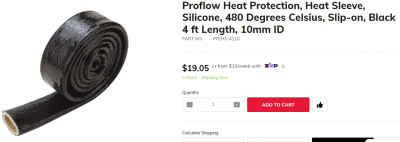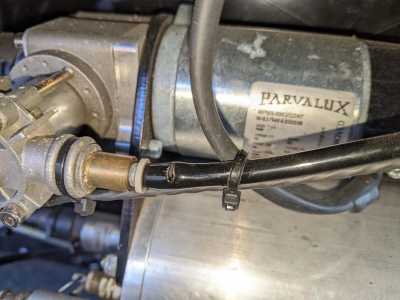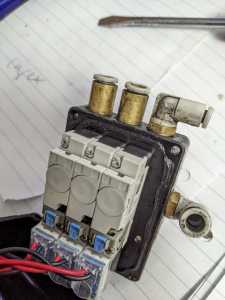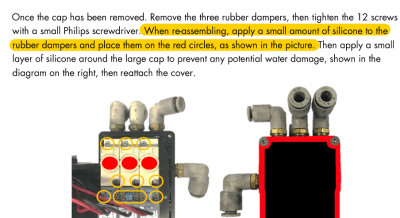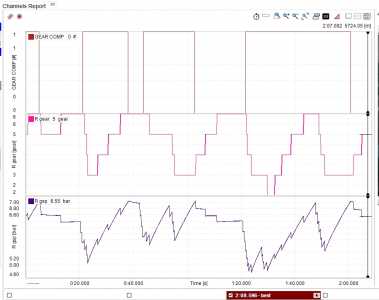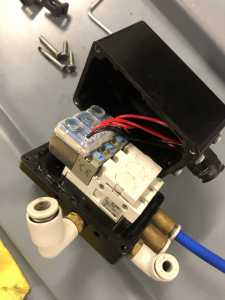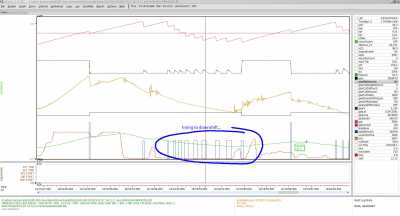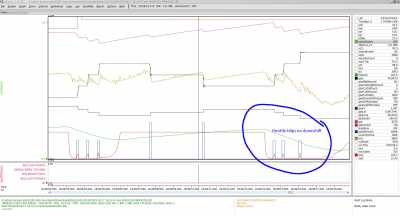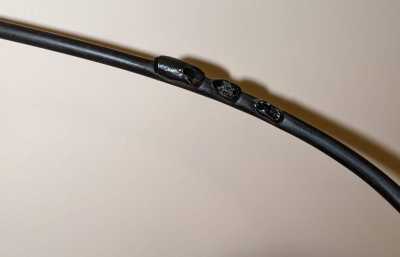
first ever big technical problem - lost shifts, compressor pressure etc.
so this happened:
after about 2 laps...my first ever 2 laps in the dry at silverstone GP, a dream come true...........i started to lose downshifts.
It was one or 2 at first, then it got worse. I had upshifts, but downshift would not engage after multiple pulls on the paddle, then it randomly would. I lived with it for about 15 minutes but after that it got bad enough that there was no point driving.
Back to the paddock after 30+ minutes of this... first thing the team did was adjust the metal plate on the blipper that can bend back over time.
We then ran the car with the wheels up - the pressure was keeping up @ 7 bar, no loss of pressure. After a few shifts going up and down the gears the compressor would kick in and recharge the pressure, so that all seemed fine. Going up and down again through the gears was all fine, it was shifting through.
Went out in the 3rd and final session - same problem immediately, upshifts fine, downshifts no. Pulled back in after about 10 minutes of just trying to drive round the problem but it got to the point where i was driving about 5 seconds off the pace so back to the pits - a radical engineer plugged in the laptop and saw my blipper wasn't activating, then noticed the airline running to the back of the engine had got damage, a few holes caused by melting.
They replaced it in the pitlane and i went back out - at first it seemed to work, but after 1 lap it happened again.
Came back to the pits, and this time i'd lost upshifts too - as i came to a stop i could hear the compressor stuck on, and the dash was showing 5.1X bar constantly, and not charging back to 7 - that's the first time i've seen that happen.
I've been told the first thing i should do is replace all the rubber lines running from the compressor and the solenoid block first and that should fix it.
i don't quite understand the connection between the blipper and preventing downshifts, but anyway i've been told its a cheap fix to replace and check/replace the apparently 'rubbish' connectors for these pipes, and that should hopefully fix it.
What do you guys think? how should i diagnose and how would you approach finding a solution?
very sad way to end, i experienced my childhood dream for all of 2 dry laps 😪
also before i go and start stabbing away at everything with a screwdriver, is it quite easy to remove the tubes and reconnect everything? where are the connectors from?
At least you got to do a couple of laps at your dream track... more than most of us will ever do there... and I'm sure you will get other opportunities too
I have had the downshift issue myself... it was also the first technical problem I had with my car.
In my case the polyurethane (they are not rubber) hose got too hot in a small section and that caused a hole to blow out in the tube - you could see it was a hole made under pressure as it had stretched the material out in a bubble which caused the wall thickness to get thinner and the pressure then caused a hole.
I replaced it with bowden tube made from Teflon which has a much higher temperature rating than the Radical supplied hose. (it's used on 3d plastic printers to guide/feed the wire in, and has the precise dimensions needed to suit these fittings)
There is a thread on the Forum about this and also where to get the material (I believe the bowden tube is an upgrade, but there are also details of the Radical supply which is less costly than many of us thought it would be.)
When I installed the replacement I also decided to put some better heat shroud material around it
Here is what I used...
...no problems since.. and suspect this is a permanent fix.
I haven't had the 'loss of compressor pressure' that you have now had... but I was a maintenance engineer at a local industry and we used A LOT of the same type of pneumatic lines and fittings as used on our cars. I can promise you there isn't much wrong with the quality of fittings used on our cars... certainly not to warrant you changing them all for something essentially the same. It sounds like there is probably nothing wrong with your compressor... just that you have a bad leak somewhere and the compressor cant keep up with the leak when the pressure is around 5.1x bar... I would have thought a leak of that size would be easy to hear...
Suggest yind a quiet place (workshop at home) and try running the compressor up until it reaches that point where the pressure stops rising, then turn off the main switch to stop the compressor - you will probably hear where the air is leaking. Taking the left hand sidepod off will probably be necessary to check over the entire system anyway. Maybe take that off before doing the above test as the leak could be in that area anyway. If you can't hear it you will definitely feel it by running your hand over the air lines... and worst case you could use soapy water and you will find it.
... and to answer your last question... YES - there is a trick to removing the pneumatic air lines from the fittings!
You need to push on the tube (pushing it along its length into the fitting - the reverse of what is logical), while also pushing in the same direction with your fingers on the other hand on that little plastic ring that is an the end of the fitting.... once you have done that then the tube can be pulled out (while you still hold pressure on that ring) It's important to do it in that order - 1 push the tube, 2 push the ring, 3 pull the tube out
Reassembly is easier - just push the tube in until you feel it bottom out or feel a click.
@rjbender awesome, thanks.
Ok so here's what i found....
- hole in tube...
now i don't know if this was the initial cause of the problem, because the compressor was still repressurizing up to 7 bar whilst still not being able to downshift smoothly (which we thought was fixed by replacing the blipper tube but it didn't). However i assume this definitely caused the final problem, which was the compressor not pressurizing above 5 bar anymore.
so...hopefully replacing this line from pump to tank will fix that?
i'm also puzzled as to how a hole appeared there in the first place, i'm wondering if its because it was cable tied to a wire quite firmly and over time a small amount of tugging here and there maybe twisted the tube? i've no idea, is this an area where you'd expect a lot of heat? i wouldn't have thought so.
- next up, the valve block.
It was very easy to prize open, and it looks like there isn't much silicon around the corners. I don't know if this is what was causing the shifting issues, and that pressure was being lost out of here? Or is the silicon to seal the large cap only for waterproofing?
in any case, i'm goign to remove the old silicon and apply some new silicone generously all round - any advise on what to use?
- now i've got the valve block out, i might as well carry out the maintenance recommended in the mechanics guide....
but i'm puzzled where it says this:
- i dont get it...i don't have any rubber dampers that sit on top of that white block? Is this a different design of block? should i just skip this step?
@rojid - glad I could help and that you found the problem.
I think you definitely had two separate problems (a hole in the blipper tube and the hole in the main tube) Odd that they happened so closely together but I am 100% sure you had a hole in the blipper tube to as if you listen to your original video there is no throttle 'blip' on downshift, despite that the car still managed to downshift on some occasions, even if you had to pull the paddle quite often to get this to happen. That proves the compressor, the solenoid valve block and the larger actuator that actually moves the gearboxes shift lever were all working fine. That was exactly the same symptoms that I had with mine when the blipper tube got a hole in it.
Regarding your question about the photo of the hole in the main supply line you found... The reason it failed there is 100% due to temperature and nothing to do with the zip tie, etc. When you run any compressor the air gets hot. The air is hottest nearest to the compressor outlet... and cools down by losing heat through the tube wall. So the further away from the compressor outlet the lower the likelihood of this happening.
You can see in your photo that the tube has a slight bulge out where the hole is right where the compressor outlet is... this is due to the material softening from the inside and the pressure then pushes the material outwards and it gets thinner as a result. Once this starts it always fails, since the thinner it gets the more it expands with the heat and pressure. You just need to replace the tube - easy.
Re the solenoid block - I don't bother with silicone sealant on mine anymore. It has zero to do with the function and is just there to keep water out.
Mine did not have any rubber stoppers there on the red dots in the picture either... so I skipped this step. Radical were obviously aware that the issue with these units is that the vibration causes the three solenoids to come loose and then the very fine rubber gaskets that are under the solenoids (between the bottom surface if the solenoid valves and the base of the billet aluminium housing). They have obviously tried to dampen this vibration down by putting a rubber spacer between the top of each solenoid and the inside of the billet case lid... basically helping to clamp the solenoid down.
As part of my maintenance schedule I now test if there are any leaks developing after each race meeting by first turning on the main switch and getting the compressor to run. Once you have done that, then turn the main switch off. Go back to the car 10+ hours later, and turn the switch back on... if the compressor runs then you have a leak. When the solenoids are tight on mine it can go more than a week before the compressor comes back on. That probably more than OK and I am normally happy if the compressor will hold pressure for at least 6+ hours. If it's less than that then just take out the solenoid block and tighten the small screws again (but not too much). All that is much easier done without the sealant on the aluminium housing.
Finally, in case you are interested in having some spares... much cheaper than available from others... see this post for parts and details (and prices I paid a few years ago)
@rjbender so i think i've got a leaky valve block... i've tightened the screws etc, put it back in car, ignition on...
It pressurized up to 7 bar again (at least thats good news, no issues with compressor), and the moment it stopped i can see the number slooowly tick down. I cycled it through a few times, it takes 3 minutes 45 seconds for it to drop from 7 to 6 bar, at which point it recharges. From the test yesterday i came back overnight and it was reading 3.45bar, so it had lost half it's pressure overnight.
I spoke to James at Radical who gave some good insight -
"Holding pressure for almost 30 mins between recharges is fine, you’ve got nothing to worry about. We would say holding pressure (between 7 and 6 bar) for 2 mins is acceptable, 5 mins is good, if you have 30 mins you’re fine!"
However if you are dropping pressure on track more than expected it could be down to the rate at which it builds up pressure. We don’t have any metrics on this but if its low check battery voltage and if its still low consider replacing the compressor side of the motor. I wouldn’t be too worried though.
i did tighten the valve block screws as much as i dared - it looks like someone had already been at it previously and the plastic screw heads were all a bit damaged so i couldn't tighten those.
I turned all 6 metal screws maybe half a turn, but the plastic ones (which i'm guessing are the key ones) i couldn't tighten further.
I don't know to what extent my valve block is leaky. Here's the data over a 2m 8 lap of silverstone:
You can see that a shift 'costs' me roughly 0.2 bar, and the compressor is on for a large chunk of the lap due to multiple shifts. When it's not recharging it was holding pressure fine.
i've found a UK supplier for 3 of those valve blocks + screw/gasket spares as per your post in the other thread, super helpful. Much more reasonable than paying £700 for a new valve block from radical. Are the valves easy to remove/refit?
on a seperate note - what's the safest way to release pressure from the system so i can remove the valve block again? when i did it before there was some pressure still inside and when i removed the main feed line from the valve block there was a burst of air as the tube popped out....
Conclusion - now that i've replaced all the lines and put silicone heat wrap around it, i'm sure my shifting issues are cured for now. I'll keep monitoring the data and if the rate at which i'm losing pressure starts to rapidly increase then i'll know it's the valve block (or something else!) and will at least have some backup valves to replace inside the valve block. I've just ordered those parts from a UK supplier - 4 week lead time - £31.50 each for the valves, £4 each for the gasket/screw. I've ordered 3 valves and 5 gaskets.
@rojid - Great to hear we are making progress and sounds like your starting to get a good feel for the system - that is always a good start!
I would not be too worried if the system is leaking as much as you have outlined above... and I agree with James' way of describing it.
Of course it's better if it holds pressure for longer, but ultimately each time you actuate a gear change sequence there will be a loss of some pressure as the solenoid valves let air out of the pressurised system and into the actuators (gear change cylinder and the blipper cylinder on downshifts as well) and after the air does it's job it is exhausted to atmosphere...
I'm not sure what plastic screws you are talking about. The main screws to tighten are the 6 long steel ones that are in the main part of the solenoid valves (the ones that hold it onto the billet/anodised aluminium base. This joint is where the gaskets you have purchased are located and where most of the leaks occur... so it's these screws that should be tightened. The other six steel screws (that are closer together) hold the electrical solenoid onto the pneumatic part of the valve - these should be tight but I don't think they cause an air leak.
Like I said above I'm not sure where the plastic screws are you mentioned...
The way I diagnose how long my compressor runs while on track is to look at the AiM data and check/log Battery Voltage. What you will see is that when the compressor runs it drags the voltage down to a much lower level.. so my car runs at close to 14v (the charging voltage from the alternator) and gets depressed by around 1.5V from memory when the load from the compressor is introduced. I haven't got my laptop nearby to check this or send a screenshot, but if you pull some logged data up from your car before it had any shifting issues, then you will see that the compressor probably runs with about 30%-40% duty cycle (it's on for about 30-40% of each lap). This obviously depends on how often you are changing gears... but if you look at the Voltage data logged you can see it really clearly. When you encountered that leaky tube near your compressor - then the compressor was probably running 100% of the time... or at least much more often than normal....
This Voltage check is part of what I look at after each run... and by doing that I hope to get an early warning of a small leak or 'issue' before it causes me a DNF or lost track time.
Great to hear you have identified a local supplier for these parts. They are very easy to change, although small and fiddly. The rubber gaskets are really tiny and you need to make sure they are installed in the correct location. I used a small amount of rubber grease to hold them into the groove on the bottom of the valve block from memory.. but I'm sure you will work it out. If the gasket get's pinched because its not in the right location it will probably leak badly...
Finally, you last question about how to bleed pressure out of the system before you pull the tubes off - I'm not sure that is easily done. If you still have the sidepod off the car and can access the pneumatic air tank near the compressor - there is a bleed off valve (main pressure relief valve) located on it. It is a brass fitting from memory and should have a pull ring on it. Pull that and I think it will release the air pressure... but if your doing this at a track, then you wont have easy access to that - so I think it is just a matter of pulling off the tube while it's pressurised... it can't hurt much.
re: the screws - i'm referring to the same ones, you can probably see on my photo they are all faded and worn, maybe somehow the heads have got corroded over time and now they look plastic!
anyway, i've been studying the LIFE data using the gears workbook.......i'm not convinced i've fixed the problem. The blipper wasn't blipping, even after the tube had been replaced.
the above is taken from the final stint - after the radical engineer had replaced the blipper tube which was full of heat holes - and before i lost downshifts altogether after the compressor stopped charging above 5 bar due to the hole in that tube.
Looking at the data from the last time i ran the car.........the difference is in the throttle trace - i'm seeing the blips in the throttle trace/TPS
so now i'm thinking, Either
- The blipper tube immediately developed holes again, in the heat
- there's something else wrong with the blipper itself.
i've sent the file to James/Radical technical..... we'll see.
EDIT:
LOL SUCCESS................nipped into the garage, pull out the blipper cable, and Whatdyaknow...........
alright........problem.....Solved. Hopefully.
I had some shabby heat protection around that tube which i hadn't paid any attention to in my almost 2 years of ownership so far. When they swapped the tube in the pitlane i guess they couldn't cover it appropriately so after a lap it melted almost immediately.
Time to order some 4mm PTFE and more heat protection.
Agree... "Time to order some 4mm PTFE and more heat protection."
There is a thread on the Forum about this and also where to get the material (I believe the bowden tube is an upgrade, but there are also details of the Radical supply which is less costly than many of us thought it would be.)
https://radicalsportscarregistry.com/radicalforum/how-to-diy-discussions/what-material-should-be-used-on-the-pnumatic-shifter-air-lines/#post-7607 /a>
When I installed the replacement I also decided to put some better heat shroud material around it
Here is what I used...
...no problems since.. and suspect this is a permanent fix.
Good info, but where is it necessary to protect the pneumatic hose against excessive heat? I have had three SR3s, (Gen 3&4), and never any problem with melting hoses. Is this something that earlier SR3s had, or it potentially affects all models?
It looks like it starts from the air solenoid block, up to nearby chassis tube, then in the back of the engine case and just in front transmission outshaft interface, along the back of the engine, then straight up to the throttle blipper assembly. I don't see any heat shield on that tube.
I beg your pardon -- upon close inspection the blipper tubing on my SR3 is wrapped in heat shield. It is such a snug fit that I did not notice it.

